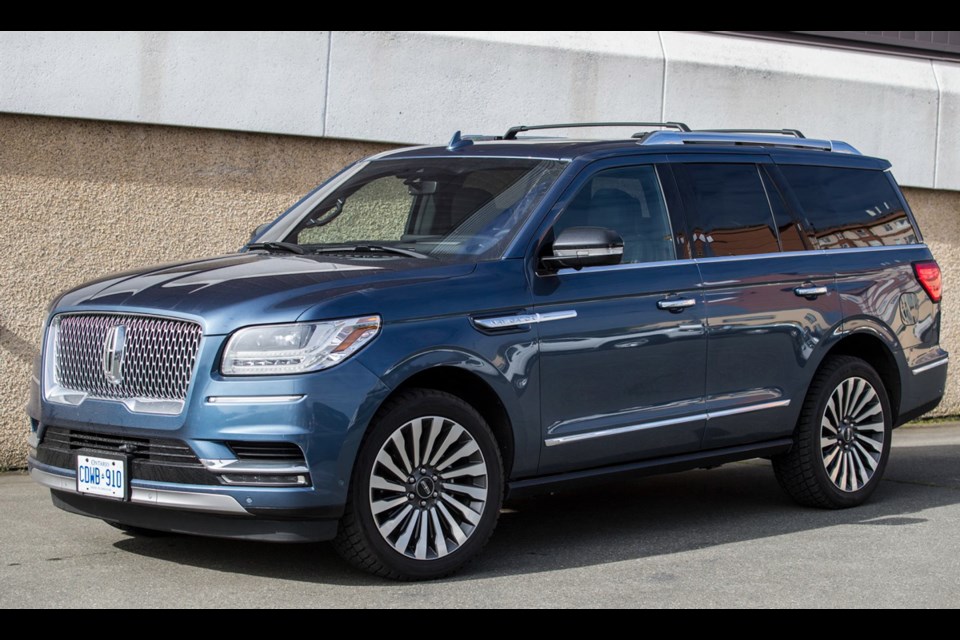If you belong to that segment of the market that flies business class — or takes your own jet — the 2018 Lincoln Navigator might be the perfect Earth-bound equivalent.
With an overall length of 5,334 millimetres, sitting more than 1,900 mm tall and tipping the scales at nearly 2,759 kilograms, the Navigator epitomizes full-size as few in its class can.
But there’s more.
For those who can’t resist an offer to “supersize,” the Navigator can even be ordered with a discreet “L” after its name, with an extra 300-plus millimetres added to its body.
I drove the regular 2018 Navigator with the more luxurious Reserve trim, with a starting price of more than $90,000.
This is not a car for anybody hugging trees or shy about flaunting their wealth.
With the Navigator, nobody can say they never noticed you arriving. Like the Queen Elizabeth II cruise ship, when the Navigator arrives at a destination, it is sure to draft the majority of vehicles. The exception would be a full-size Ford truck, as that would be the humble platform from which the Navigator rose.
Like its cousin, the majority of the Navigator’s body is now clothed in aluminum, which helps keep its weight in check, despite being larger than the previous generation, which drove off into the sunset last year.
The style of the new Navigator, while redesigned for this year, is unmistakably Lincoln, with its signature massive chrome mesh grille and a purposely boxy body.
It might be visually sleeker and more contemporary than the vehicle it replaces, but it never loses its imposing presence. A darker hue makes it stand out less, but everybody who sees it knows it’s just visual sleight of hand — nobody is fooled.
Unlike many vehicles out there, the Navigator sticks to its traditional truck past with a body bolted onto a full steel ladder frame. The only concession is a fully independent rear end with a multi-link suspension that improves on a truck’s solid rear end and leaf springs.
A few years back, Lincoln retired its trusty V-8 and replaced it with a turbocharged 3.5-litre V-6 (again similar to what can be found under the hood of an F-150). Although it was already found in last year’s Navigator, the engine was tweaked this year, managing to find 450 horsepower and 510 foot-pounds of torque (70 hp and 50 lb.-ft. of torque more than before).
Despite the increase in power, Lincoln claims fuel economy of 14.9 litres per 100 km city and 11.3 on the highway. That’s an improvement over last year, but the engine now requires premium-grade fuel. The mileage is helped by a stop/start system that turns the engine off at stops.
The Navigator boasts six drive modes that adjust the shift points on the 10-speed automatic, adjust the adaptive suspension or optimize traction or fuel economy.
True to its truck roots, the Navigator has a tow/haul mode to handle towing up to 3,810 kilograms (8,400 lbs.).
While I have so far looked at the Navigator’s capabilities, I can now talk about what it offers for the occupants.
Old-world opulence is clearly the first impression of the Navigator.
A list to document the numerous standard features would take up most of this page. The driver and front passenger are bombarded with a dizzying list of options for individual comfort. The front of the seat bottoms can be individually adjusted, for example, for people who prefer one leg more supported than the other.
Power pedals adjust to accommodate those with longer or shorter femurs.
The seat backs have upper and lower controls as well as heat in the winter and air conditioning in the summer. In total, the seat can be adjusted 30 ways, plus it has a massage function.
The Lincoln does fall behind in that last feature, as Mercedes-Benz offerings have up to three different types of massage styles in different parts of your back, should that be of interest to you.
The cabin is a visual and tactile indulgence, with real wood under a surface that feels like glass and supple leather that envelops the body.
The Navigator is like a luxury car on steroids, with head and legroom over and above what any full-size sedan can offer.
Luxury these days also means vehicles with a heavy dollop of technology as well — and the big boy delivers. The dash is merely a screen to which a driver can customize what he or she wants to see. The centre infotainment screen handles everything else.
Second-row passengers get their own screens on the backs of the front seats, along with climate control at their fingertips.
Depending on the configuration, seven or eight adults can travel in luxury — comfortably — together with their luggage. Second- and third-row seats fold at the touch of a button found at the rear hatch.
The Lincoln Navigator reminded me of a tour of the Palace of Versailles I took while on vacation in France — at the sense of awe at all the opulence. The Lincoln Navigator isn’t for most of us. But for those who have the means, it is a interesting blend of old-world stately elegance repackaged for a changed world.
The spec sheet
Type: Luxury full-size SUV, front engine, 4X4
Engine: Twin turbocharged 3.5-litre V-6, 450 hp at 5,500 r.p.m., 510 hp at 3,000 r.p.m.
Transmission: 10 -speed automatic
Dimensions (mm): Length, 5,334; width, 2,030; height, 1,939; wheelbase, 3,112
Curb weight (kg): 2,759
Price (base/as tested): $90,500/ $101,600 (includes $2,000 freight and PDI and $100 AC tax)
Options: Floor mats $150, heavy-duty trailer tow $2,000, Tech package $3,000, perfect position seating $1,000, rear entertainment system, $2,350, tiered cargo management $500
Tires: 285/45 R22 on alloy wheels
Fuel type: Premium
Fuel economy (L/100km): 14.9 city/ 11.3 highway
Warranty: Four years/80,000 km new car, six years/110,000 km powertrain



